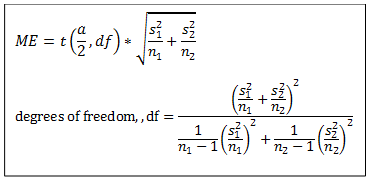- Dependent variable is continuous (measured on interval or ratio scale of measurement).
- Independent variable is categorical (grouped into 2 independent samples)
- There is no relationship/dependency between 2 samples
- Method of simple random sampling is used
- Data is normally distributed
Heterogeneity of variance between 2 independent samples. This can be tested using Levene’s Test or F test
Null and Alternative Hypothesis
- Ho: there is no significant difference in the population means of 2 groups. μ1-μ2=0
- Ha1: there is significant difference in the population means of 2 groups. μ1-μ2≠0 (Two tailed test)
Ha2: population mean of sample 1 is less than that of sample 2. μ1-μ2<0 (Left tailed test)
Ha3: population mean of sample 1 is greater than that of sample 2. μ1-μ2>0 (Right tailed test)
Test Statistic

Critical value
- -t(a/2,df),t(a/2,df) (Two tailed test)
- -t(a,df) (Left tailed test)
- t(a,df) (Right tailed test)
P-value
- 2*(1-P(T≤|t|) (Two tailed test)
- P(T≤t) (Left tailed test)
- P(T≥t) (Right tailed test)
Decision rule
- Reject Ho if |t| > t(a/2, df) or p-value < alpha (two tailed test)
- Reject Ho if –t < -t(a, df) or p-value < alpha (left tailed test)
- Reject Ho if t > t(a, df) or p-value < alpha (right tailed test)
Standard error (SE) and margin of error (ME) is given by:

100(1-alpha)% Confidence interval for the population mean difference is given by:

This implies I am 100(1-alpha)% confident that estimated population mean difference between two samples lies in the obtained interval. If confidence interval contains 0, I fail to reject null hypothesis ho and conclude that there is no significant difference in the means of two samples.